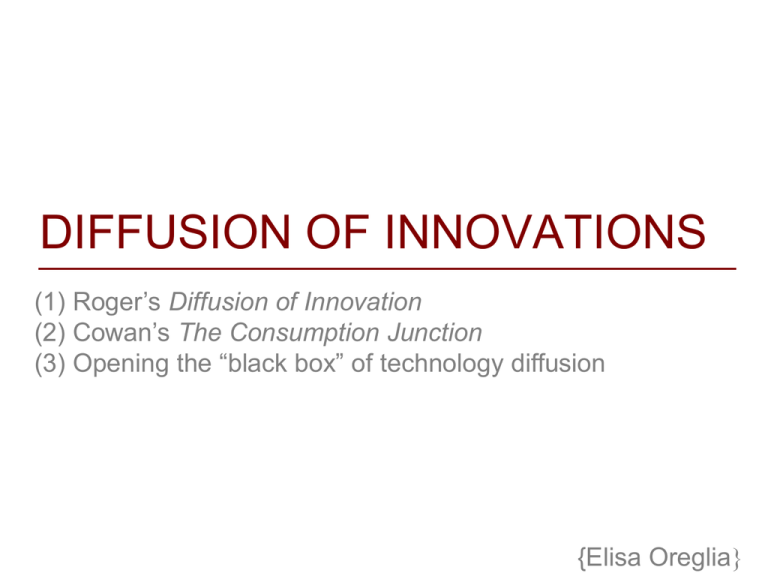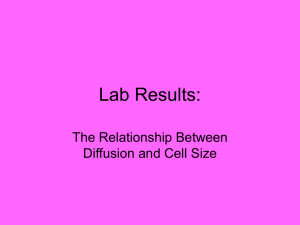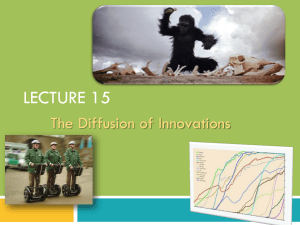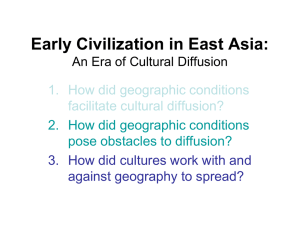Diffusion-of-Innovations_Feb11-2013
advertisement

DIFFUSION OF INNOVATIONS
(1) Roger’s Diffusion of Innovation
(2) Cowan’s The Consumption Junction
(3) Opening the “black box” of technology diffusion
{Elisa Oreglia}
Social Histories
SCOT
ANT
Diffusion of Innovations
Consumption Junction
Social-Technical Gap
Technological Determinism
Social Determinism
Technological Change one artifacts supplants another
Technological Determinism an artifact reorganizes social structures
Technological Diffusion how an artifact diffuses through society
(Cowan, p261)
The “Social-Technical Continuum”?
Diffusion of Innovations: The Core Question
“How do consumers arrive at the decision to choose
one technology over its alternative?”
Diffusion of Innovations - Rogers
http://blog.kitetail.com/2007/09/12/could-accelerated-diffusion-rate-negatively-impact-innovations/
http://www.designdamage.com/when-to-adopt-social-media-for-your-business/
http://suewaters.wikispaces.com/Rogers
Diffusion of Innovations - Rogers
• Rogers: rural sociologist, son of farmers, interested in
agricultural issues in US and developing countries:
– “Categorizing the Adopters of Agricultural Practices”
(1958)
– “Characteristics of Agricultural Innovators and Other
Adopter Categories” (1961)
• “Diffusion of Innovation” (1962-2003)
• Rogers & the I School:
– “Emphasis on diffusion as information-exchange among
participants in a communication process” (xvi preface 1995
edition)
– “The diffusion of innovations is essentially a social process
in which subjectively perceived information about a new idea
is communicated. The meaning of an innovation is thus
gradually worked out through a process of social
construction.” (xvii 1995)
Diffusion of Innovations - Rogers
Diffusion of Innovations - Rogers
• 4 elements of diffusion:
–Innovation (perception of innovation)
–Communication Channels
–Time
–Social Systems
• Vignettes
–Btw: “The Fable of the Keys”
http://www.utdallas.edu/~liebowit/keys1.html
Diffusion of Technology - Cowan
• “… asking both what interest such a
consumer might have had and what sort of
network might have existed at that time to
bring a stove into a home.” (Cowan, p269)
• Failure & Success are equally important to
understand diffusion
• Stoves: past and present of diffusion
(http://www.aprovecho.org/lab/index.php)
Diffusion of Technology - Cowan
Cowan, p270
Diffusion: Opening the “black box” experiment
Goal:
To “open up the “black box” of diffusion (the final stage).”
(Cowan)
What:
Drawing from today’s readings, devise a plan for Nokia to
regain market share in mobile phones:
- group work (4-5 people), presentations, discussion
- be as general or as specific as you wish
(e.g. company-wide plan, or target a specific country/age
group/etc)
- use specific concepts from the readings
(e.g. concepts like “opinion leaders/change agents,” “perceived
attributes of innovations,” etc if referring to Rogers, “who sold, at
what price, were there wholesalers, etc” if referring to Cowan)
Diffusion of Innovations - Rogers
• Importance of DoI research:
– Diffusion follows a pattern
– Importance of social networks (‘strength of
weak ties’ follows in the wake)
– Xiao et al. on Diffusion & Games (“The rich
traces users leave in the form of social networks and
interactions online have started to enable researchers to
conduct large-scale studies of diffusion patterns” p2)
– Attention to marginal populations &
developing countries
– Work-in-progress
Diffusion of Innovations - Rogers
• Critiques to DoI:
– Innovation: what is it, exactly?
– Time: on/off? Long-term?
– Social Systems
• The problem of the ‘network’ described
by Cowan
Diffusion of Innovations - Rogers
• (self)-criticism of DoI (ch.3)
• Pro-innovation bias (“innovation should be diffused and adopted by
all members of a social system, should be diffused more rapidly, the
innovation should be neither re=invented nor rejected.” p100)
• Individual blame (“If the shoe doesn’t fit, there’s something wrong
with your foot” p115)
• Time variable difficult to measure because it relies on recall
• Problems in determining causality (“Cross-sectional survey data
are unable to answer many of the “why” questions about
diffusion… The pro-innovation bias in diffusion research, and the
overwhelming reliance on correlational analysis of survey data, often
let in the past to avoiding or ignoring the issue of causality among the
variables of study.” p123)
• Equality problem (esp. in relation to developing countries)
Diffusion of Innovations: Descriptive, yes; Predictive?
“The S-Shaped curve only describes cases of successful innovation, in which an innovation spreads to almost all of the
potential adopters in a social system. Many, many innovations are not successful. The S-curve, it must be remembered, is
innovation-specific and system-specific, describing the diffusion of a particular new idea among the member-units of a
particular system, The S-curve of diffusion is so ubiquitous that students of diffusion may expect every innovation to be
adopted over time in an S-shaped pattern. However, some innovations do not display an S-shaped rate of adoption,
perhaps for some idiosyncratic reason or another… The main point here is not to assume than an S-shaped rate of adoption is
an inevitability. Rather, the shape of the adopter distribution for an innovation ought to be regarded as an open question, to be
determined empirically.” (Rogers, p261)
Social Histories
SCOT
ANT
Consumption Junction
Diffusion of Innovations
Appropriation
Social-Technical Gap
Technological Determinism
Social Determinism
The “Social-Technical Continuum”








